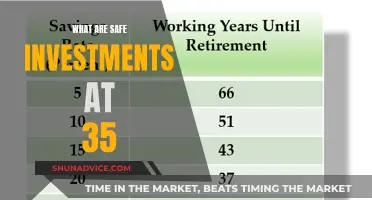
Building a balanced investment portfolio is a challenging task that requires careful consideration of your financial goals, risk tolerance, and investment horizon. A well-diversified portfolio is essential to help manage market risk and achieve your long-term objectives. Here are the key steps to constructing a balanced investment strategy:
- Determine your financial goals: Understand your unique objectives, such as saving for retirement, buying a house, or building an emergency fund.
- Assess your risk tolerance: Evaluate your comfort with risk. Conservative investors typically favour lower-risk investments like bonds and cash, while aggressive investors are willing to take on more risk by investing primarily in stocks.
- Define your investment horizon: Consider your age and time horizon. Younger investors can generally afford to take on more risk, while those closer to retirement may opt for more conservative strategies.
- Choose your asset allocation: Allocate your investments across different asset classes, such as stocks, bonds, cash, and alternative investments. Diversify your portfolio to reduce risk by investing in a mix of domestic and foreign stocks, different market capitalisations, and a combination of government and corporate bonds.
- Monitor and rebalance: Regularly review your portfolio to ensure it aligns with your goals and risk tolerance. Adjust your investments as needed to maintain your desired asset allocation.
By following these steps, you can build a balanced investment portfolio that meets your financial goals and risk appetite. Remember to seek professional advice if needed, as building a robust investment strategy requires significant time and knowledge.
| Characteristics | Values |
|---|---|
| Financial goals | Retirement, house, emergency fund |
| Investment timeframe | Short-term or long-term |
| Risk tolerance | Conservative, aggressive Moderately aggressive |
| Investment types | Stocks, bonds, cash, mutual funds, exchange-traded funds, index funds, real estate, futures, commodities, financial derivatives, etc. |
| Diversification | Different sectors, U.S. and international stocks, large cap and small cap stocks, value and growth stocks, government and corporate bonds, etc. |
| Rebalancing | Periodically re-evaluate and adjust investment allocation to maintain desired risk level and maximize returns |
What You'll Learn

Understand your goals, risk tolerance, and time horizon
Understanding your goals, risk tolerance, and time horizon is a crucial first step in building a balanced investment portfolio. Here are some detailed insights to help you through this process:
Understanding your goals: The first step in investing is to identify your unique financial goals and objectives. For instance, are you investing for retirement, saving for a house, or building an emergency fund? Clearly defining your goals will help you tailor your investment strategy accordingly.
Time horizon: Determining when you will need the money is essential. If you're investing for retirement, your time horizon is likely to be much longer than if you're saving for a short-term goal like a down payment on a home. A longer time horizon generally allows for more aggressive investment strategies, while a shorter time horizon may call for more conservative approaches.
Risk tolerance: Assessing your risk tolerance is crucial in building your portfolio. It refers to how comfortable you are with market volatility and potential losses. Conservative investors tend to have a lower risk tolerance and prefer less risky investments like bonds and cash. On the other hand, aggressive investors are willing to take on more risk for higher potential returns and typically invest a larger portion of their money in stocks. Your age and life stage also play a role in determining your risk tolerance. Younger investors in their 20s or 30s can generally afford to take on more risk, while those closer to retirement may opt for more conservative investments to preserve their capital.
It's important to note that there is no one-size-fits-all approach to building a balanced investment portfolio. Your goals, time horizon, and risk tolerance are unique to your financial situation and will guide the creation of a customized investment strategy.
Additionally, it's worth mentioning that diversification is a key component of building a balanced portfolio. Diversification involves spreading your investments across different asset classes, sectors, and industries to reduce risk. By not putting all your eggs in one basket, you lower the impact of market fluctuations on your portfolio.
Young Adults: Best Places to Invest Your Savings
You may want to see also

Diversify your portfolio across asset classes
Diversifying your portfolio across asset classes is a crucial aspect of building a balanced investment portfolio. Here are some detailed instructions and considerations to help you diversify effectively:
Understanding Asset Classes
Firstly, it's important to understand the different asset classes available to you. The three main asset classes are stocks (equities), bonds, and cash. Stocks typically offer higher growth potential but come with higher risk, while bonds and cash are less risky but may provide lower returns. Other asset classes to consider include real estate, commodities, foreign currencies, and derivatives such as futures and options.
Determining Your Investment Goals and Risk Tolerance
Before diversifying your portfolio, you should clearly define your investment goals and risk tolerance. Are you investing for retirement, a house, or an emergency fund? How soon will you need the money? Are you comfortable with taking on more risk for potentially higher returns, or do you prefer a more conservative approach? Your answers to these questions will guide your diversification strategy.
Allocating Across Asset Classes
Once you understand your goals and risk tolerance, you can start allocating your investments across different asset classes. Consider dividing your portfolio into a mix of stocks, bonds, and cash to manage risk and maximize return potential. For example, if you're investing for retirement at a young age, you may allocate a larger percentage to stocks due to their higher growth potential. On the other hand, if you're closer to retirement, you may want to increase your allocation to bonds or cash to reduce risk.
Diversifying Within Asset Classes
Diversification isn't just about spreading your investments across different asset classes; it's also about diversifying within each class. For example, when investing in stocks, consider diversifying across different sectors, such as technology, healthcare, and finance. You can also diversify between domestic and international stocks and between large-cap and small-cap stocks. Similarly, when investing in bonds, you can diversify by term (short-term vs. long-term) and type (government vs. corporate bonds).
Monitoring and Rebalancing
Diversification is an ongoing process. Regularly monitor your portfolio to ensure it remains aligned with your investment goals and risk tolerance. Over time, the performance of different asset classes may cause your initial allocations to shift. Therefore, it's important to periodically rebalance your portfolio by adjusting your holdings to return them to your desired allocations. This may involve buying or selling certain investments to maintain your intended diversification strategy.
Benefits of Diversification
By diversifying your portfolio across asset classes, you can reduce risk and potentially improve your long-term investment returns. Diversification helps protect your portfolio from significant losses in any single asset class. Additionally, different asset classes perform differently in various economic environments, so a well-diversified portfolio can provide more consistent returns over time.
Savings and Investments: Equation for Financial Success
You may want to see also

Choose individual assets for your portfolio
Choosing the right asset allocation is one of the most critical investment decisions you will make. The three main asset classes are stocks (equities), bonds, and cash. Your asset allocation will depend on your financial goals, investment timeframe, and risk tolerance.
If you are saving for retirement at a younger age, you may be more willing to have a larger percentage of your assets invested in stocks due to their higher growth potential. On the other hand, if you are closer to retirement, you may want to allocate more towards bonds or money markets, which are less risky.
When choosing individual stocks, it is important to select those that satisfy your desired level of risk within the equity portion of your portfolio. Consider factors such as sector, market capitalization, and stock type. Use stock screeners to shortlist potential picks, and then conduct a more in-depth analysis to determine the opportunities and risks associated with each potential investment.
When choosing bonds, consider factors such as coupon rate, maturity, bond type, and credit rating, as well as the general interest rate environment. You can also invest in mutual funds or index funds, which are managed by professionals and tend to have lower fees.
Exchange-Traded Funds (ETFs) are another option, offering the benefits of diversification and cost savings compared to mutual funds. They are passively managed and track a chosen index or basket of stocks.
Remember, it is crucial to maintain diversification across your portfolio. Ensure your holdings are spread across different subclasses and industry sectors within each asset class.
Invest Your Savings Wisely: A Guide for Nigerians
You may want to see also

Monitor and rebalance your portfolio
Even after you've built a balanced investment portfolio, your work isn't done. It's important to continually monitor your portfolio and make adjustments as necessary. Here are some tips for monitoring and rebalancing your portfolio:
- Periodically reassess your portfolio weightings: Changes in price movements may cause your initial weightings to change. Analyse your portfolio's actual asset allocation by categorising the investments and determining their values' proportion to the whole.
- Consider tax implications: When rebalancing your portfolio, factor in the tax consequences of selling certain assets, especially if they are subject to capital gains. In some cases, it may be more prudent to cease investing in that asset class rather than incurring capital gains taxes.
- Evaluate the outlook for your securities: If you suspect that a particular investment is performing poorly and is likely to continue to do so, you may want to sell it, even if there are tax implications. Analyst opinions and research reports can be useful tools to help you make these decisions.
- Maintain diversification: Remember that diversification is key to managing risk. Ensure that your holdings within each asset class are spread across an array of subclasses and industry sectors.
- Consider the impact of inflation: Inflation can affect the value of your investments and the returns you can expect. In a low-interest-rate environment, consider shifting more of your allocation into inflation-protected fixed-income securities.
- Monitor your risk tolerance: As your financial situation, future needs, and risk tolerance change over time, you may need to adjust your portfolio accordingly. For example, if your risk tolerance has decreased, you may need to reduce the number of equities held.
- Rebalance strategically: When rebalancing your portfolio, decide which underweighted securities you will buy with the proceeds from selling overweighted securities. Use the same approaches you used when initially selecting your investments (e.g., analysing stocks, choosing bonds, etc.).
- Seek professional advice: Building and maintaining a balanced investment portfolio can be complex and time-consuming. Consider working with an experienced financial advisor who can help you monitor and rebalance your portfolio based on your changing needs and risk tolerance.
Maximizing Cash Savings: Best Investment Options for You
You may want to see also

Consider a financial advisor
Building a balanced investment portfolio can be a complex and time-consuming process. It requires a good understanding of financial markets and investment strategies, as well as the ability to monitor and rebalance your portfolio periodically. Therefore, it may be beneficial to consider seeking advice from a financial advisor.
A financial advisor can help you build a long-term investment strategy that is tailored to your goals and risk tolerance. They will be able to determine your investment profile and select investments that match your changing needs and risk appetite. This can be particularly useful if you are unsure about your financial goals or how much risk you are comfortable with.
Additionally, a financial advisor can provide ongoing support and guidance. They can help you monitor your portfolio's performance and make necessary adjustments to ensure it remains aligned with your goals. This can be especially valuable during times of market volatility or when your personal circumstances change.
When choosing a financial advisor, it is important to select one who is experienced and reputable. You should also ensure that they are registered and licensed to provide investment advice. It may be helpful to research different advisors, compare their services and fees, and read reviews from their clients to make an informed decision.
By working with a financial advisor, you can benefit from their expertise and gain peace of mind knowing that your investment portfolio is being professionally managed. This can help you feel more confident about your financial future and allow you to focus on other aspects of your life.
Remember, investing involves risks, and there is no one-size-fits-all approach. Even with the help of a financial advisor, it is essential to understand your own financial situation, goals, and risk tolerance to make informed decisions about your investments.
Is a 529 College Savings Plan a Smart Investment?
You may want to see also







